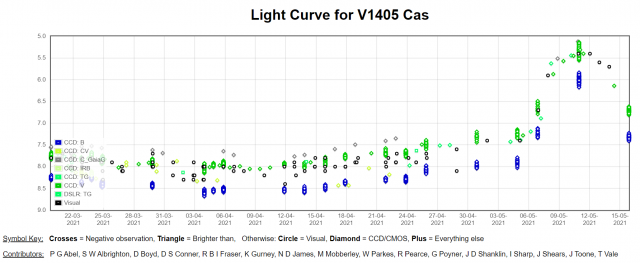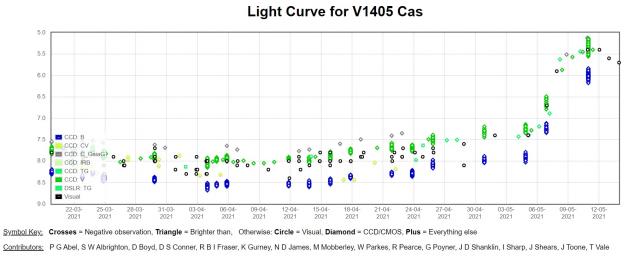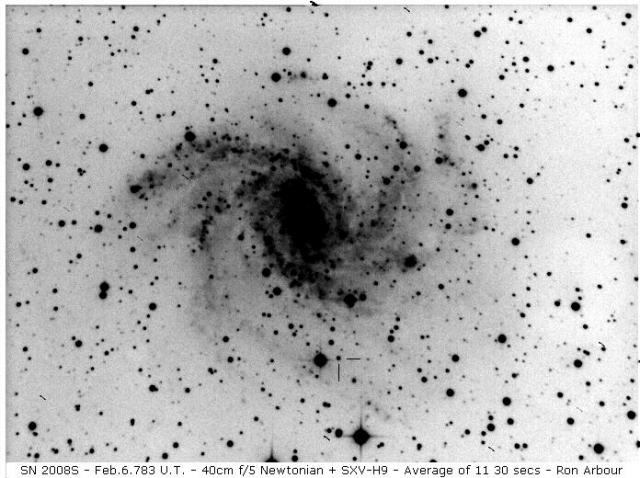Forum Replies Created
-
AuthorPosts
-
 Jeremy ShearsParticipant
Jeremy ShearsParticipantA 6 x 30 finder is pretty small, Astrosteve, so perhaps not surprising he was having trouble finding targets. I’d recommend a 50 mm finder as this should allow a beginner plenty of opportunities to star hop without resorting to electronic gadgets. You can pickup finders of really good quality quite cheaply these days. They have a field of ~6 degs and should easily get to mag 9.5.
 Jeremy ShearsParticipant
Jeremy ShearsParticipantGood to see your photometry run, Maxim. Thank you!
My first reaction, like yours, is it’s probably flickering. But time will tell
 Jeremy ShearsParticipant
Jeremy ShearsParticipantDragon’s Den? “I’m out”
 Jeremy ShearsParticipant
Jeremy ShearsParticipantLatest plot from VSS database

 Jeremy ShearsParticipant
Jeremy ShearsParticipantYes, Astrosteve: a cheap finder (likely already have, but with removable eyepiece), the adapter that Tim linked to, and a cheap detector (could be webcam or a low cost CCD/CMOS detector, depending on how much sensitivity, field of view and cost one is happy with). So, all commercially available individually or as the complete unit. Plenty of options for you.
 Jeremy ShearsParticipant
Jeremy ShearsParticipantKato-san posted the following on VSnet overnight:
“V1405 Cas rapid fading
Several observers have noted rapid fading.
Itoh-san’s data:
May 14 V=6.11, B-V=+0.57
May 15 V=6.95, B=V=+0.27This fading is apparently not caused by dust formation.”
 Jeremy ShearsParticipant
Jeremy ShearsParticipant Jeremy ShearsParticipant
Jeremy ShearsParticipantHere’s a plot from the BAA Variable Star Section database. Looks like it is past the peak, BUT this type of nova might have a second (or third) peak. Keep watching!

 Jeremy ShearsParticipant
Jeremy ShearsParticipantThat’s super, Maxim. Good luck!
 Jeremy ShearsParticipant
Jeremy ShearsParticipantI’ve seen a naked eye observation of the nova, reported on the VSnet list. Filipp Romanov observing from Nakhodka, Russia (nr Vladivostok, 42degN) had it at 5.1 vis last night (2021 05 10.75). “It was easily seen next to the star 4 Cas against the background of the Milky Way”, Romanov notes.
This is the first NE obs report I’ve seen. It will be interesting to hear if a BAA member gets to see it with their NE, although its position is quite challenge, along with bright skies.
 Jeremy ShearsParticipant
Jeremy ShearsParticipantNews in from Kato-san at vsnet overnight that V1405 Cas might be brightening. Several observers in Japan reported vis or V=7.4 on Apr. 26. He notes “The nova before this brightening was apparently in “premaximum halt” “.
Time will tell – further observations encouraged!
 Jeremy ShearsParticipant
Jeremy ShearsParticipantCharts and sequence on AAVSO website here.
 Jeremy ShearsParticipant
Jeremy ShearsParticipantGreat to hear you’ve successfully uploaded your data, Mike. Hopefully the first of many!
Go well!
Jeremy Jeremy ShearsParticipant
Jeremy ShearsParticipantDid you get the binoculars out, Nick?
 Jeremy ShearsParticipant
Jeremy ShearsParticipantRobin makes an important point here about alert systems. There are many such available.
One that might be of interest to BAA Members is the BAA VSS Alert Group. You can find out how to sign up here.
The aims of the group are to distribute information on variable vtar activity currently observed by BAA VSS members. The Nova discovery was announced there.
Hope you get some more clear sky, Robin!
 Jeremy ShearsParticipant
Jeremy ShearsParticipantHello Mike,
im also happy to have a look if you send me your S/sheet, one of your FITS files and, if possible, a screenshot from AIP4WIN showing the variable and comparisons apertures marked.
The other thing you can do whilst learning is to compare your results with others in the databases. I have not looked up this star so I don’t know whether there are data, otherwise you can also try another star for which there are data
Go well!
Jeremy Jeremy ShearsParticipant
Jeremy ShearsParticipantThanks Tony. I’ve not had any problems since using the hub, so I will let sleeping dogs lie
 Jeremy ShearsParticipant
Jeremy ShearsParticipantRon Arbour has asked me to post this message in his behalf:
The object AT2021 recently discovered in NGC 4631 has been classified as a Luminous Red Variable which is a sub group of Intermediate Luminosity Optical Transients. This group included Intermediate Luminosity Red Transients and intermediate Red Novae among others and bridged the gap between Novae and Supernovae. The first discovery and hence archetype of all these objects was discovered by an amateur and member of the Association, namely myself. A paper on the object was published in the Journal.
J.Br.Astron.Assoc. 126, 3, 2016
 Jeremy ShearsParticipant
Jeremy ShearsParticipantFurther doubt cast on the ALMA detection of phosphine in Venus’s atmosphere: “Complications in the ALMA Detection of Phosphine at Venus”
26 January 2021 at 9:16 am in reply to: Webinar: Peranso 3 Light curve Analysis Software – Live Showcase #583746 Jeremy ShearsParticipant
Jeremy ShearsParticipantI’ve just heard from Tonny Vanmunster that both a recording of the webinar and the PowerPoint slides used can be accessed from the Peranso website.
Highly recommended.
-
AuthorPosts
